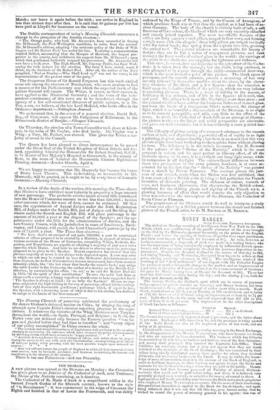THE DIORAMA.
A NEW picture was opened at the Diorama on Monday ; the Coronation has given place to an Interior of the Cathedral of Auch, near Toulouse ; the Shrine of the Nativity remaining, as it deserves.
The Cathedral of St. Marie d'Auch is a magnificent edifice in the bastard French Gothic of the fifteenth century, known as the style of "la Renaissance" : it was commenced in the reign of CHARLES the Eighth and finished in that of Louis the Fourteenth, and was richly
endowed by the Kings of France, and by the Counts of Armagnae, of which province Auch was at that time the capital, as it had been of an- cient Gascony. The body of the church is entirely built of tufa, a soft freestone of fawn colour, the blocks of which are very smoothly chiselled and exactly joined together. The most remarkable features of the edifice are forty massive round pillars, ranged in four rows, and forming a triple nave, with side-chapels : these lofty pillars are striped vertically with fiat raised bands, that spring from the capitals into ribs, groiniug the arched roof. The painted windows are remarkable for beauty of design ; they are in fact a series of transparent pictures, and rank amongst the finest works of stained glass in the world : the carvings of the stalls in the choir, too, are exquisite for lightness and richness. This view, however, does not do justice to the splendour of the Cathe- dral: it is taken from the transept ; but the choir, being enclosed, is only glimpsed at by a peep through the richly-ornamented door-way, which is the most attractive point of the picture. The blank space of pavement, and the smooth columns, present a monotony of hue very scantily relieved by decorative marbles about the altars, by the cleres- tory windows of the choir, and a few figures : thus the attention is fixed upon the iudtative details of the painting, which are very inferior to preceding pictures. There is a want of solidity in the masses, of brilliancy in the colours, and of life in the figures : all is cold, thin, and poor. The pillars look more like Tunbridge-ware than stone ; and the painted windows have neither the luminous richness of stained glass, nor even the lustre of a transparent blind : moreover, the change of light, which is so beautiful a characteristic of the Diorama, is so slight as to be scarcely perceptible, and adds very little to the effect of the scene. In short, the Cathedral of Auch fails as an attempt at illusion : the picture is clever ; the linear and aerial perspective are admirable, and parts are well executed ; but it is too evidently a mere painted imi- tation.
The difficulty of giving variety of texture and substance to the smootk surface of tufa, and of producing a powerful effect of reality in so light a painting, is great, unquestionably ; but there is no doubt that this very picture might have been worked up to the requisite force without altering its tone. The deficiency is in the artist's resources. Yet M. RENOUX is the painter of the " Shrine of the Nativity," which is the most gorgeous in colour, and the most perfect in illusory effect, of all the dioramic views : to be sure, it is a twilight and lamp-light scene, while its companion is all daylight. The extraordinary difference between these two productions of the same painter, however, is at once ac- counted for by the fact that the " Shrine of the Nativity " was painted from a sketch by DAVID RonEnTs. The contrast proves the just- ness of our remark, made when the Shrine was first exhibited, that it was reserved for a British artist to bring to full perfection the French invention of dioramic painting. The richness of colour, warmth of tone, and luminous chiaroscuro, that characterize the British school, substitute for the chilling gloom and rigidity of the French style, a glowing harmony of effect that would remove the only objection to what was otherwise the masterpiece of the Diorama, the Cathedral of Santa Croce at Florence.
The proprietors of the Diorama would do well to interpose a study of colour and effect by a British painter between the sketch and finished picture of the French artist, be he M. BOUTON or M. RENOUX.


























 Previous page
Previous page